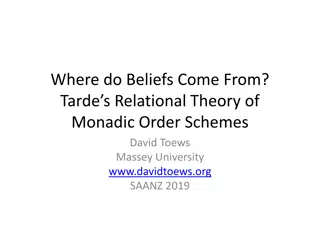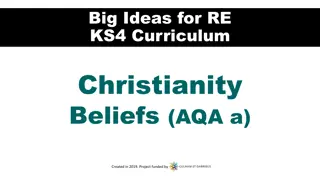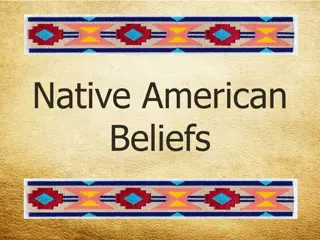Understanding Sikhism: History, Beliefs, and Practices
Sikhism, originating in the 15th century in Punjab, teaches the principles of equality, honest living, and devotion to one God. Explore the history of Sikh Gurus, the significance of the five Ks, and the main practices followed by Sikhs in their daily lives.
Download Presentation

Please find below an Image/Link to download the presentation.
The content on the website is provided AS IS for your information and personal use only. It may not be sold, licensed, or shared on other websites without obtaining consent from the author. Download presentation by click this link. If you encounter any issues during the download, it is possible that the publisher has removed the file from their server.
E N D
Presentation Transcript
What is What is Sikhism? Sikhism?
Learning objectives To be able to understand the basic history of Sikhism To know what the five K s are at the end of the lesson To understand what a Gurdwara is To understand the main Rites of passenger of Sikhs
How did Sikhism begin? Around 1500 CE Punjab area of South Asia (Now parts of India and Pakistan) Guru Nanak started teaching Sikhism At the time the area was distinctly Hindu and Islamic
What are the Gurus? There have been 10 human Gurus The Guru is seen as an enlightened teacher, not a God Each Guru would appoint his successor The last human Guru (Guru Gobind Singh) appointed the Sikh sacred texts as the final and enduring Guru (Referred to as Sri Guru Granth Sahib)
What are the 5 Ks? What do they Represent? This is called the Khanda. So what are the 5 K s? This Symbol represents some of the concepts of Sikhism. The Khanda is made up by some of the 5 K s.
What are the 5 Ks? The 5 K s are objects that most Sikhs carry to represent different aspects of their religion. The reason they are called the 5 K s is because the name of all 5 objects begin with a K. Sikhs who carry these 5 K s are called Khalsa. Khalsa meaning pure. Both men and women can carry the 5 K s. Each one of the 5 K s has a different significance, but they all just as important as each other. The 5 K s are
Kesh Kesh means uncut hair. This applies for all body hair, women and men. Uncut hair symbolizes holiness and strength. Hair is part of God s creation, by having uncut hair it shows the acceptance of God s gift.
Kara The Kara is a steel bracelet. The Kara is worn on the right wrist. The Kara symbolizes eternity, showing God has no beginning or end. The Kara also represents restrained and not doing anything against the Guru s wishes.
Kachehra/Kaccha The The Kachehra helps to stop one from making the wrong moves, and remind them of their duty. Kachehra is a pair of underwear. The Kachehra symbolizes chastity. The Kachehra should not go below the knees.
Kanga The Kanga is a wooden comb. It is important to look after God s creation (our body). The Kanga is used to brush the uncut hair, keeping it neat and tidy. The Kanga symbolizes a clean body and a clean mind.
Kirpan The rule is never do injustice and never let anyone else do injustice The Kirpan is a sword. The Kirpan represents courage and defence. The Kirpan symbolizes self- defense, defense of God and defense of the weak.
What are the Temples and What are the Temples and its Procedures? its Procedures?
What is the place of worship? The Gurdwara is the Sikh place of worship. Gurdwara means gateway to the guru.
Services Services are based on the writings in the Guru Granth Sahib. A scripture of a collection of teachings. Together with chants and prayers from the gurus known as keertan.
Services The service ends with a shared meal known as langar. Langar is served to everyone who attends the Gurdwara. The food is shared out by the Granthi, which is the person who looks after the Gurdwara.
Rites of Passage in Sikhism Rites of Passage in Sikhism
What is a Nam Karan? When both the mother and child are ready to move about, they are taken to the Gurdwara along with the rest of the family. They recite hymns from the Guru Granth Sahib. Karah Prashad and Amrit are prepared. The new-born's name is chosen from the Hukam. The Granthi randomly opens a page from the Guru Granth and recites the hymn on that page. The name is chosen by the first letter of the first word on that hymn.
What is an Anand Karaj? A Sikh marriage is called Anand Karaj. The Guru Granth Sahib is present during the wedding ceremony. While reciting the Lavan the couple must walk around the Guru Granth Sahib four times. Wedding ceremonies can be performed by any Sikhs who has gone through the Armit initiation. Sikhs believe in monogamy. Widows and widowers may remarry. Child marriage is forbidden.
Funeral Rites Death is considered a natural process. Public displays of grief at a funeral is discouraged and so is worshipping the dead with gravestones. Cremation is what Sikhs prefers. Before cremation the body is cleaned and clothed by a family member. Hymns are recited, while being cremated they recite a night time prayer and Ardas is performed. Non continuos reading of the whole Guru Granth Sahib takes place and concludes on the 10th day.
What have you learnt What have you learnt anything today? anything today?
How many human Gurus were there? A) 15 C) 10 B) 2
What does Khalsa mean? A) Pure C) Spiritual B) Holy
What is a Gurdwara? A) A house full of Holy people B) A sacred bangle C) A temple where Sikhs go for prayers
What is Armit? A) Holy salt water B) Sweet water C) Sacred water























